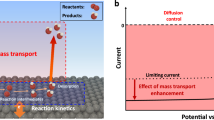Abstract
Despite its many favorable properties as a sample support for biological electron microscopy, graphene is not widely used because its hydrophobicity precludes reliable protein deposition. We describe a method to modify graphene with a low-energy hydrogen plasma, which reduces hydrophobicity without degrading the graphene lattice. Use of plasma-treated graphene enables better control of protein distribution in ice for electron cryo-microscopy and improves image quality by reducing radiation-induced sample motion.
This is a preview of subscription content, access via your institution
Access options
Subscribe to this journal
Receive 12 print issues and online access
$259.00 per year
only $21.58 per issue
Buy this article
- Purchase on Springer Link
- Instant access to full article PDF
Prices may be subject to local taxes which are calculated during checkout



Similar content being viewed by others
Change history
10 June 2014
In the version of this article initially published, the arrow in Figure 1b pointing to the 0–110 reflection was in the incorrect location. The error has been corrected in the HTML and PDF versions of the article.
References
Grigorieff, N. & Harrison, S.C. Curr. Opin. Struct. Biol. 21, 265–273 (2011).
Bai, X.-C., Fernandez, I.S., McMullan, G. & Scheres, S.H. Elife 2, e00461 (2013).
Dubochet, J. et al. Q. Rev. Biophys. 21, 129–228 (1988).
Robertson, J. Adv. Phys. 35, 317–374 (1986).
Miyazawa, A. et al. J. Mol. Biol. 288, 765–786 (1999).
Brilot, A.F. et al. J. Struct. Biol. 177, 630–637 (2012).
Henderson, R. & McMullan, G. Microscopy 62, 43–50 (2013).
Geim, A.K. Science 324, 1530–1534 (2009).
Lee, C., Wei, X., Kysar, J.W. & Hone, J. Science 321, 385–388 (2008).
Russo, C.J. A structural imaging study of single DNA molecules on carbon nanotubes. PhD thesis, Harvard Univ. (2010).
Pantelic, R.S., Meyer, J.C., Kaiser, U., Baumeister, W. & Plitzko, J.M. J. Struct. Biol. 170, 152–156 (2010).
Pantelic, R.S. et al. J. Struct. Biol. 174, 234–238 (2011).
Sader, K. et al. J. Struct. Biol. 183, 531–536 (2013).
Gómez-Navarro, C. et al. Nano Lett. 7, 3499–3503 (2007).
Elias, D.C. et al. Science 323, 610–613 (2009).
Méndez, I. et al. J. Phys. Chem. A 110, 6060–6066 (2006).
Russo, C.J. & Golovchenko, J.A. Proc. Natl. Acad. Sci. USA 109, 5953–5957 (2012).
Israelachvili, J. & Pashley, R. Nature 300, 341–342 (1982).
Curtis, G.H. & Ferrier, R.P. J. Phys. D Appl. Phys. 2, 1035–1040 (1969).
Downing, K.H., McCartney, M.R. & Glaeser, R.M. Microsc. Microanal. 10, 783–789 (2004).
Reina, A. et al. Nano Lett. 9, 30–35 (2009).
Li, X. et al. Science 324, 1312–1314 (2009).
Lieberman, M.A. & Lichtenberg, A.J. Principles of Plasma Discharges and Materials Processing 2nd edn. (Wiley, 2005).
Taherian, F., Marcon, V., van der Vegt, N.F.A. & Leroy, F. Langmuir 29, 1457–1465 (2013).
Dubochet, J., Groom, M. & Mueller-Neuteboom, S. Adv. Opt. Electron Microsc. 8, 107–135 (1982).
Regan, W. et al. Appl. Phys. Lett. 96, 113102 (2010).
Selmer, M. et al. Science 313, 1935–1942 (2006).
Wasilewski, S., Karelina, D., Berriman, J.A. & Rosenthal, P.B. J. Struct. Biol. 180, 243–248 (2012).
Tang, G. et al. J. Struct. Biol. 157, 38–46 (2007).
Scheres, S.H.W. J. Struct. Biol. 180, 519–530 (2012).
Mindell, J.A. & Grigorieff, N. J. Struct. Biol. 142, 334–347 (2003).
Voorhees, R.M., Weixlbaumer, A., Loakes, D., Kelley, A.C. & Ramakrishnan, V. Nat. Struct. Mol. Biol. 16, 528–533 (2009).
Pettersen, E.F. et al. J. Comput. Chem. 25, 1605–1612 (2004).
Armache, J.-P. et al. Proc. Natl. Acad. Sci. USA 107, 19754–19759 (2010).
Scheres, S.H.W. & Chen, S. Nat. Methods 9, 853–854 (2012).
Rosenthal, P.B. & Henderson, R. J. Mol. Biol. 333, 721–745 (2003).
Acknowledgements
We thank J.A. Golovchenko for the use of a chemical vapor–deposition instrument at Harvard for graphene synthesis during the initial phases of this work; S. Scotcher for fabrication of custom sample holders and copper punch machines; I.S. Fernandez, A. Kelley and V. Ramakrishnan of the Medical Research Council (MRC) Laboratory of Molecular Biology for the gift of ribosomes; J. Grimmett, T. Darling, G. McMullan and S. Chen for technical assistance; and E. Rajendra, R.A. Crowther, D. Neuhaus, X.C. Bai, S. Scheres, N. Unwin, A.R. Faruqi and R. Henderson for helpful discussions and comments. This work was supported by the European Research Council (ERC) under the European Union's Seventh Framework Programme (FP7/2007-2013)/ERC grant agreement no. 261151 to L.A.P., an MRC (UK) Centenary award to C.J.R. and MRC (UK) grant MC_U105192715 (L.A.P.).
Author information
Authors and Affiliations
Contributions
C.J.R. designed and performed the experiments and analyzed the data. C.J.R. and L.A.P. designed experiments, planned the project, interpreted the results and wrote the manuscript.
Corresponding author
Ethics declarations
Competing interests
C.J.R. and L.A.P. are inventors on a patent application related to technology described in this manuscript (US 61/865,359).
Supplementary information
Supplementary Text and Figures
Supplementary Figures 1–9, Supplementary Table 1 and Supplementary Notes 1 and 2 (PDF 7263 kb)
Source data
Rights and permissions
About this article
Cite this article
Russo, C., Passmore, L. Controlling protein adsorption on graphene for cryo-EM using low-energy hydrogen plasmas. Nat Methods 11, 649–652 (2014). https://doi.org/10.1038/nmeth.2931
Received:
Accepted:
Published:
Issue Date:
DOI: https://doi.org/10.1038/nmeth.2931
This article is cited by
-
Reversible hydrogenation restores defected graphene to graphene
Science China Chemistry (2021)
-
Cryo-EM structures from sub-nl volumes using pin-printing and jet vitrification
Nature Communications (2020)
-
Towards super-clean graphene
Nature Communications (2019)
-
Contact angle measurement of free-standing square-millimeter single-layer graphene
Nature Communications (2018)



